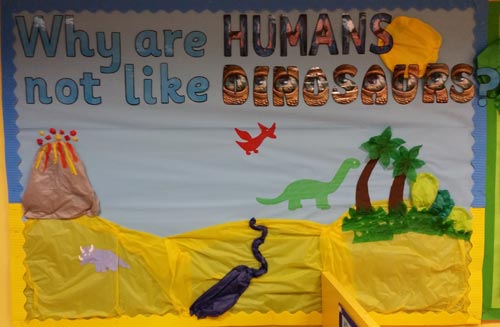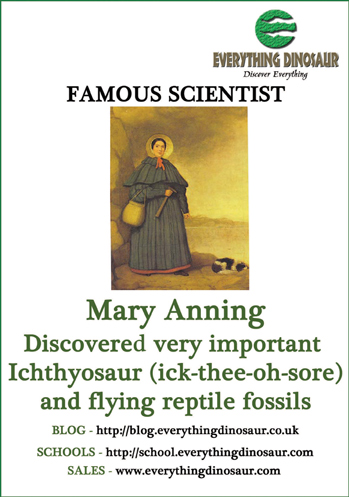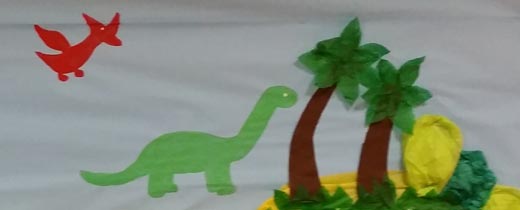Displaying Children’s Dinosaur Topic Work
Year 1 children at Lowton St Mary’s CE Primary have commenced their autumn term topic entitled “Why are humans not like dinosaurs? The children have not learned about prehistoric animals in school before, for the teacher too, this is a new topic, requiring careful planning to help cement the learning targets already achieved in Reception and to prepare the children for more directed learning tasks targeted on developing confidence with literacy and numeracy.
A Dinosaur Themed Topic
A question at the heart of the topic, provides the teaching team with a focal point on which to centre the scheme of work for the term. In this instance, the question asking about the differences between people and dinosaurs links into one of the key areas of the English national curriculum for Lower Key Stage 1, that of learning about our bodies.
The Focal Point for a Dinosaur Themed Term Topic – “Why are Humans not like Dinosaurs”?
Picture credit: Lowton St Mary’s CE Primary/Everything Dinosaur
A “Wow Wall”
A number of display areas have been prepared around the well-organised classroom to showcase the children’s work. This can provide a focal point for the children and allows good examples of writing (fiction and non-fiction), to be prominently displayed. During a visit to the school, to conduct a dinosaur themed workshop with the class to act as a provocation for the term topic, our fossil expert provided further advice as well as some handy extension resources to support planning of the topic areas.
One suggestion was to introduce the story of Mary Anning (1799-1847). This Georgian lady found a number of important fossils around the cliffs of Lyme Regis and the tongue twister “she sells sea shells” is connected with her. Mary also provides a fine role model for girls, in what otherwise might be viewed as a boy focused topic.
Mary Anning – A Famous Fossil Hunter from Dorset (southern England)
Picture credit: Everything Dinosaur
A Dinosaur Museum
Many teachers dedicate an area of the classroom for a dinosaur museum, this allows craft ideas such as fabric and clay models or salt dough fossils to be displayed. This permits the teaching team to support an area of curriculum learning related to exploring the properties of everyday materials.
During our visit we met one little boy who explained that he had some fossils at home. With permission, these items could be brought into school and put on display in the museum, this allows the teacher to explore with the children what might be needed to keep the fossils safe, how might the fossils be displayed? When creating a dinosaur museum in a classroom environment we like to ask the class what sort of rules their museum should have. Thinking about the rules for good behaviour in the museum links into the PSHE elements (personal, social, health and economic values), that are encouraged by Ofsted.
The children considering appropriate behaviour in their museum can help them to understand and develop knowledge, understanding, attitudes and responsibilities with regards to their own behaviour in the class generally.
Different Materials Used to Make a Prehistoric Animal Themed Display
Picture credit: Lowton St Mary’s CE Primary/Everything Dinosaur
A Dinosaur Themed Topic “Wow Wall”
The prehistoric animal themed display, the “wow wall” as we like to call it, was comprised of a number of different materials. This was a clever way of helping the children to explore textures as well as the properties of materials.
The Everything Dinosaur website: Everything Dinosaur.









Leave A Comment